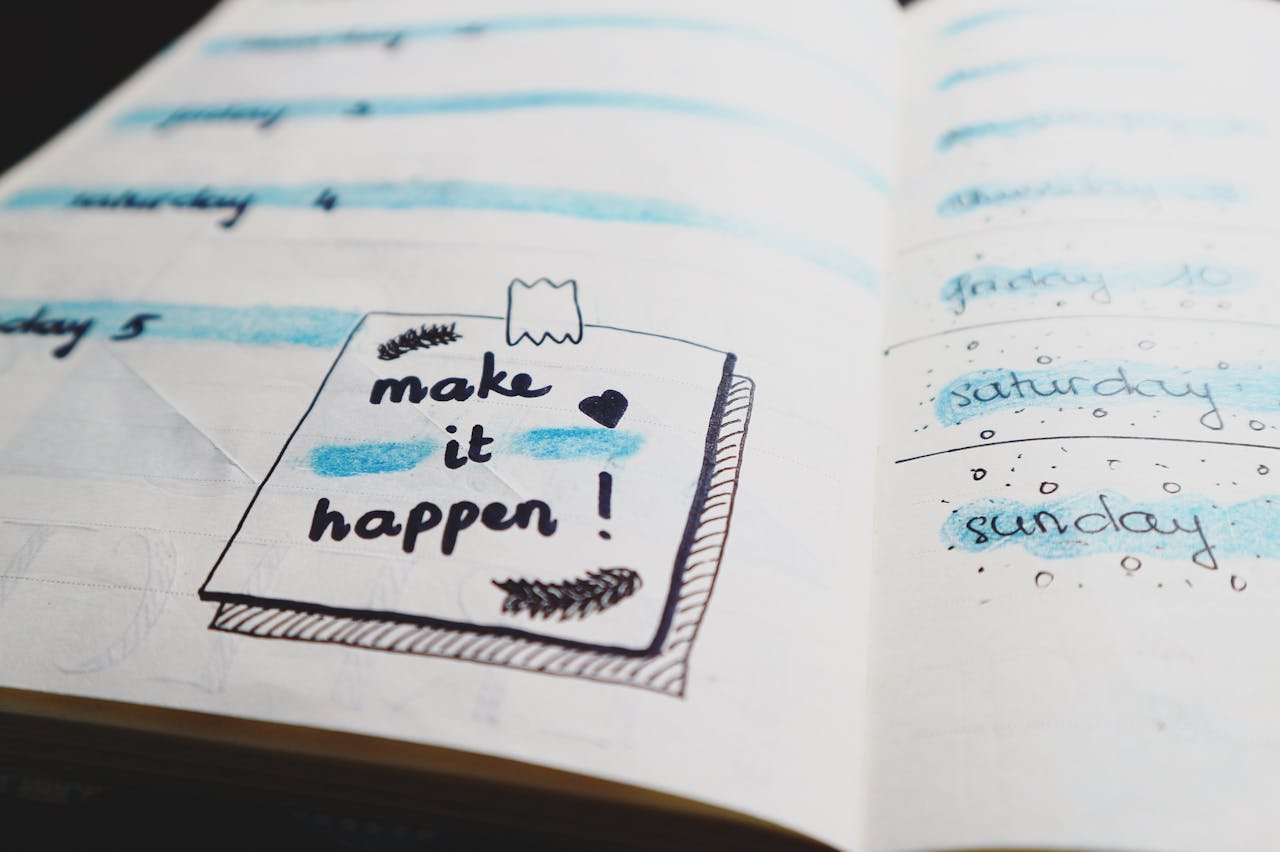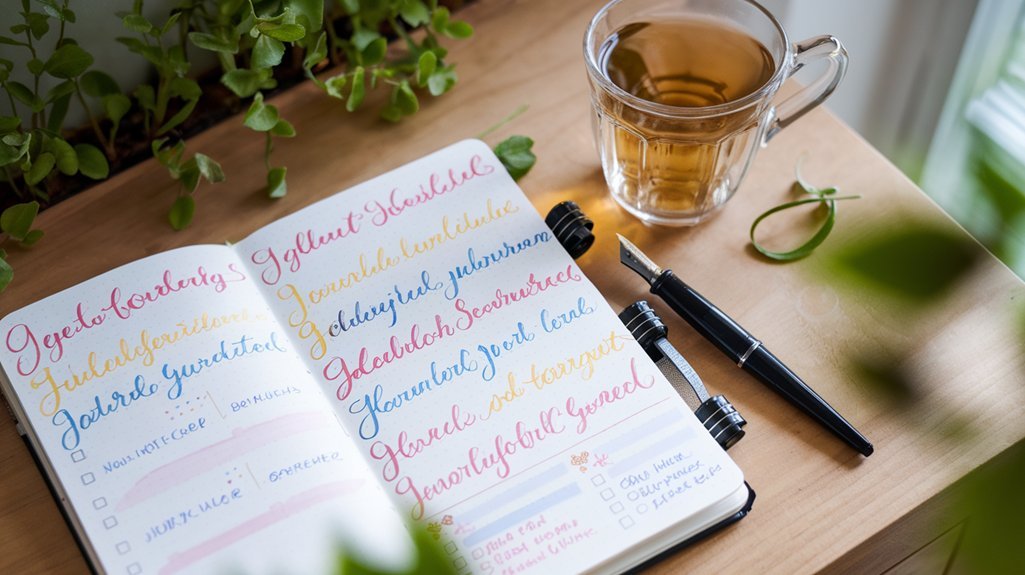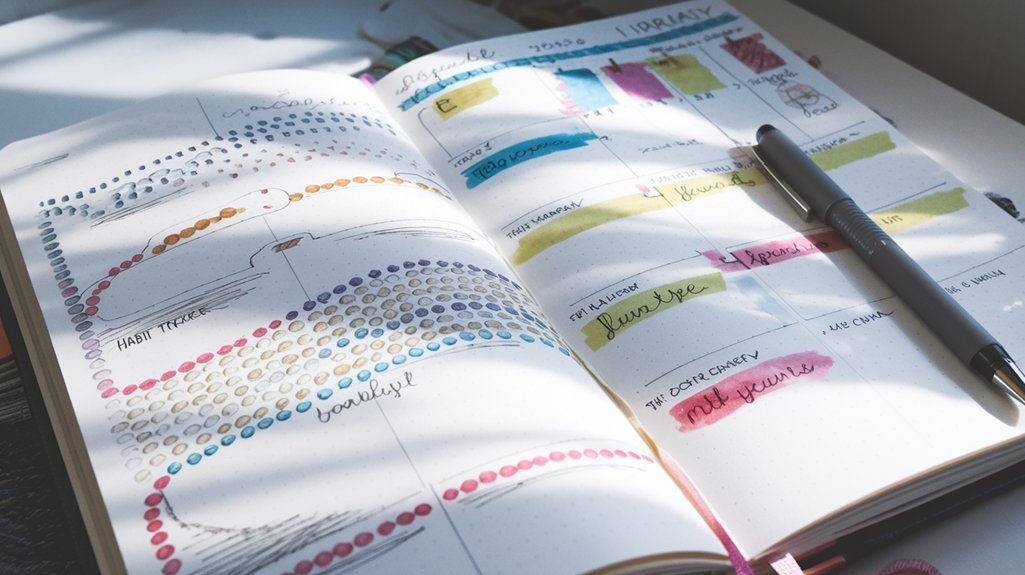You'll need a sleep tracker template that captures bedtime, wake time, total sleep duration, nighttime awakenings, and subjective quality ratings—these core metrics establish baseline patterns essential for identifying disorders. Advanced templates should include sleep stage percentages, environmental factors like temperature and noise levels, and recovery biomarkers such as heart rate variability. For athletes, correlating sleep efficiency with training load reveals critical recovery deficits. Digital formats integrate wearable data while printable versions eliminate pre-sleep screen exposure. The templates below provide structured frameworks that convert your nightly data into actionable diagnostic insights.
Key Takeaways
- Basic templates track bedtime, wake time, total sleep duration, and nighttime awakenings to establish baseline patterns for identifying disorders.
- Advanced templates incorporate sleep cycle metrics, environmental variables, and recovery scores calculated from heart rate variability and resting heart rate.
- Optimal sleep environments maintain room temperature between 60-67°F, noise below 30 decibels, and humidity at 30-50%.
- Athletes should track sleep efficiency, REM cycles, and deep sleep percentages against training load to identify recovery deficits.
- Weekly summaries consolidate daily data to reveal patterns in sleep efficiency, onset latency, and wake episodes across seven days.
Why Tracking Your Sleep Patterns Matters for Overall Health
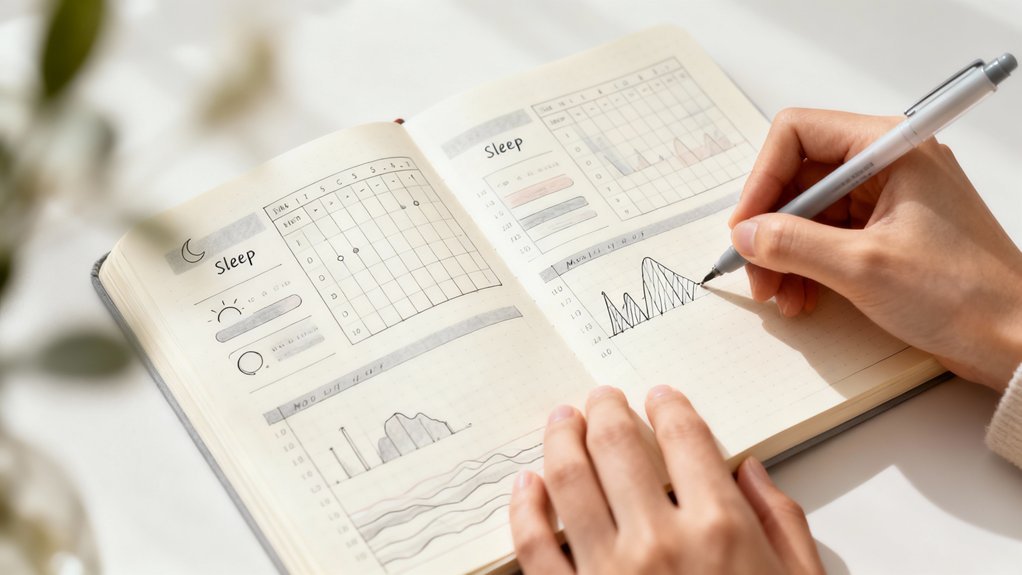
Because sleep dysfunction correlates with increased mortality risk and chronic disease progression, systematic monitoring of sleep patterns provides essential baseline data for clinical assessment.
You'll identify disruptions in your circadian rhythm that compromise restorative sleep and accelerate cognitive decline.
Tracking enables you to quantify sleep disorders before they manifest as irreversible health conditions. You're measuring objective markers that reveal connections between sleep hygiene practices and mental well being outcomes.
Measure sleep disruptions now to prevent irreversible health decline—objective data reveals critical connections traditional assessments overlook.
This data-driven approach supports targeted lifestyle changes rather than generic interventions. Your documented patterns expose stress management deficiencies and mood regulation irregularities that traditional assessments miss.
The health benefits extend beyond fatigue reduction—you're optimizing performance improvement through precise sleep-wake cycle adjustments.
Evidence shows that individuals who track sleep metrics achieve measurable improvements in inflammatory markers, glucose regulation, and cardiovascular function.
You're not just sleeping better; you're implementing preventive medicine through practical insights that convert sleep from a passive state into a controllable health variable.
Essential Elements Every Sleep Tracker Template Should Include
| Core Metric | Data Type | Tracking Frequency |
|---|---|---|
| Sleep Duration | Time-stamped | Daily |
| Wake Episodes | Numerical count | Per night |
| Recovery Rating | 1-10 scale | Morning assessment |
Your template should include space for medication logs, stress levels, and physical activity data. These correlating variables reveal patterns that isolated sleep metrics can't capture. Advanced templates integrate mood tracking and cognitive performance markers, enabling thorough analysis of your sleep-recovery relationship.
Basic Sleep Log Template for Beginners
When you're starting sleep tracking, you'll need a template that captures essential metrics without overwhelming complexity.
Your basic log should document bedtime, wake time, total sleep duration, and any nighttime awakenings—these four data points establish baseline sleep patterns necessary for identifying disorders.
A simple daily entry format guarantees consistent data collection, which enables you to recognize trends and provides clinicians with actionable information for diagnosis.
Essential Sleep Metrics Tracking
Accurate sleep documentation requires tracking five core metrics: total sleep duration, sleep onset time, wake time, number of nighttime awakenings, and subjective sleep quality ratings.
These measurements establish baseline patterns and reveal optimization opportunities you'll miss through casual observation.
Core tracking benefits include:
- Sleep efficiency calculation – Percentage of time in bed actually spent sleeping, revealing restoration effectiveness
- Latency patterns – Minutes required to fall asleep, indicating stress levels or circadian misalignment
- Fragmentation analysis – Nighttime disruptions that compromise deep sleep architecture
- Morning readiness scores – Subjective energy ratings correlating physical recovery with perceived sleep quality
- Environmental variable logging – Temperature, light exposure, and noise levels affecting sleep architecture
Consistent metric collection converts subjective experiences into actionable data, enabling evidence-based interventions that systematically improve sleep quality through targeted modifications.
Simple Daily Entry Format
Understanding which metrics matter means nothing without a practical system to record them. You'll need an efficient template that captures critical variables without overwhelming your daily habits.
Start with three essential columns: bedtime, wake time, and total sleep duration. Add rows for sleep environment factors—room temperature, noise levels, and light exposure. Include a simple rating scale (1-5) for sleep quality and daytime alertness.
Your template must accommodate intervention tracking. Document caffeine cutoff times, exercise completion, and screen exposure before bed. This structured approach alters subjective impressions into quantifiable data patterns.
You're building a diagnostic framework that reveals correlations between behaviors and outcomes. Keep entries consistent—same time daily. This precision enables you to identify which modifications genuinely improve your sleep architecture.
Advanced Sleep Quality Template for Detailed Analysis
You'll need quantifiable data points beyond basic sleep duration to identify patterns affecting your sleep architecture.
This advanced template incorporates sleep cycle metrics (REM, deep, light sleep percentages), environmental variables (temperature, noise, light exposure), and calculated recovery scores based on heart rate variability and resting heart rate.
These measurements provide diagnostic-level insights that correlate specific factors with your objective sleep quality outcomes.
Sleep Cycle Tracking Metrics
When monitoring sleep architecture, clinicians and researchers track distinct sleep stages—REM, light (N1-N2), and deep (N3) sleep—each serving specific restorative functions.
Your sleep cycle analysis requires precise measurement of stage changes, latency periods, and duration percentages. Sleep duration impact extends beyond total hours to stage-specific allocations.
Essential metrics for thorough tracking:
- Sleep latency: Time from lights-out to sleep onset (ideal: <20 minutes)
- REM percentage: Target 20-25% of total sleep for cognitive consolidation
- Deep sleep ratio: N3 should comprise 15-20% for physical restoration
- WASO (Wake After Sleep Onset): Fragmentation indicator affecting continuity
- Stage change frequency: Abnormal cycling patterns reveal underlying disorders
These quantifiable parameters enable you to identify pathological patterns, enhance intervention timing, and validate therapeutic efficacy through longitudinal data comparison.
Environmental Factors Assessment
Because external conditions directly modulate sleep architecture and consolidation efficiency, systematic environmental assessment constitutes a non-negotiable component of thorough sleep evaluation. You'll need to quantify variables that pharmaceutical interventions can't address: light pollution, room temperature, noise levels, air quality, and humidity control impact your circadian regulation mechanisms.
| Environmental Factor | Ideal Range | Assessment Method |
|---|---|---|
| Room Temperature | 60-67°F (15-19°C) | Digital thermometer tracking |
| Noise Levels | <30 decibels | Sound meter measurement |
| Humidity Control | 30-50% | Hygrometer monitoring |
Document screen exposure timing, bedding comfort ratings, and relaxation techniques employed pre-sleep. This data reveals correlation patterns between environmental modifications and sleep quality metrics. You're measuring controllable variables that directly influence neurophysiological recovery processes, enabling targeted interventions beyond traditional sleep hygiene recommendations.
Recovery Score Calculations
Quantitative recovery assessment integrates multiple physiological parameters into composite metrics that reflect your body's restorative capacity during sleep cycles.
Your recovery score synthesizes cardiovascular, respiratory, and neurological data to generate practical insights about sleep quality and readiness performance.
Advanced sleep analysis protocols incorporate:
- Heart rate variability (HRV) measurements during REM and deep sleep stages to assess autonomic nervous system balance
- Resting heart rate deviations from your personalized baseline, indicating physiological stress or recovery
- Sleep architecture percentages comparing actual versus ideal time spent in each sleep stage
- Movement frequency indices quantifying restlessness and sleep fragmentation patterns
- Respiratory rate consistency evaluating breathing stability throughout the night
These parameters combine algorithmically to produce your thorough recovery score, enabling data-driven adjustments to enhance restorative sleep outcomes.
Sleep and Exercise Recovery Template for Athletes
Athletic performance depends on sleep quality metrics that directly influence muscle protein synthesis, glycogen restoration, and neuromuscular recovery rates.
You'll need a template that tracks sleep duration alongside training load to identify recovery deficits before they impact performance. This system quantifies the relationship between nocturnal rest and physiological adaptation.
Your template should measure sleep efficiency, REM cycles, and deep sleep percentages against workout intensity and volume. Cross-reference these biomarkers with heart rate variability, morning resting pulse, and perceived recovery scores. This data-driven approach reveals patterns that conventional recovery strategies miss.
Track sleep latency post-competition and correlate it with cortisol clearance rates. Monitor how training periodization affects sleep architecture.
You'll discover ideal sleep windows for different training phases—hypertrophy requires different recovery protocols than strength or power development. This diagnostic framework changes sleep from passive rest into an active performance variable you can manipulate and enhance.
Sleep Disruption Tracker to Identify Problem Areas
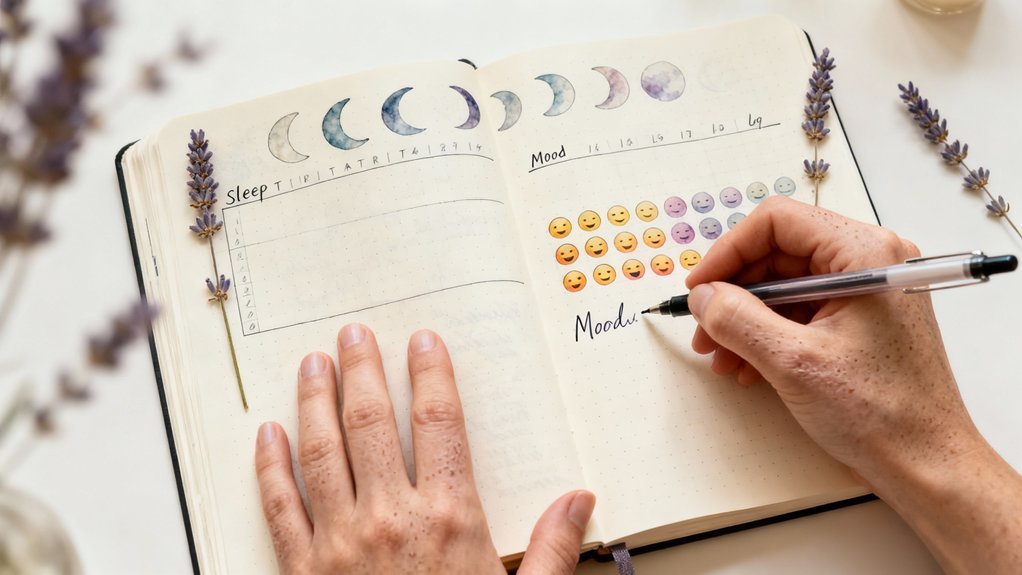
Systematic sleep problems require forensic analysis of disruption patterns rather than generalized sleep hygiene advice.
Treat sleep disruptions like crime scenes—collect specific evidence instead of applying generic solutions that miss the actual problem.
You'll need a diagnostic framework that captures sleep disruption causes with precision. This tracker isolates specific variables—environmental, behavioral, and physiological—that fragment your sleep architecture.
Document these critical disruption parameters:
- Awakening triggers: Record exact stimuli (noise, temperature shifts, bladder signals, pain) that terminate sleep cycles
- Environmental variables: Log room temperature, humidity levels, light intrusion, and ambient sound measurements
- Pre-disruption patterns: Note activities, substances, or stressors within 3 hours of each awakening
- Recovery metrics: Track time required to return to sleep after each disruption
- Temporal clustering: Identify whether disruptions concentrate in specific sleep stages or timeframes
Your tracking sleep environment data reveals actionable patterns.
When disruptions cluster around temperature fluctuations at 3 AM, you've identified a solvable variable. This evidence-based approach alters vague complaints into quantifiable problems with targeted interventions.
Weekly Sleep Summary Template for Pattern Recognition
A weekly sleep summary template consolidates your daily sleep data into measurable patterns that reveal recurring disruptions and their temporal relationships.
Track key metrics including total sleep time, sleep efficiency percentage, wake episodes, sleep onset latency, and subjective sleep quality ratings across seven consecutive days.
This aggregated view enables you to identify specific trends—such as mid-week insomnia spikes or weekend sleep debt accumulation—that single-day tracking fails to expose.
Key Metrics to Track
When tracking sleep patterns over weekly intervals, five core metrics provide the diagnostic foundation for identifying sleep disorders and circadian rhythm disruptions: total sleep time (TST), sleep onset latency (SOL), wake after sleep onset (WASO), sleep efficiency percentage, and number of nighttime awakenings.
These quantifiable parameters reveal your sleep quality trends and enhance tracking benefits:
- Total Sleep Time: Calculate your actual sleep duration minus awakenings to establish baseline requirements.
- Sleep Onset Latency: Measure minutes from lights-out to sleep initiation, targeting <30 minutes.
- Wake After Sleep Onset: Track cumulative wake time during sleep periods to detect fragmentation patterns.
- Sleep Efficiency: Divide TST by time in bed, aiming for ≥85% efficiency.
- Nighttime Awakenings: Document frequency and duration to identify maintenance insomnia.
You'll establish personalized benchmarks through consistent weekly aggregation and comparative analysis.
Identifying Sleep Disruption Trends
Recording individual metrics creates the raw data foundation, but pattern recognition emerges through systematic weekly consolidation that alters isolated measurements into actionable diagnostic information.
You'll identify sleep patterns by aggregating seven consecutive nights into comparative frameworks that reveal disruption frequencies, duration variances, and environmental correlations.
Plot wake episodes against dietary timing, caffeine intake, and exercise schedules to establish causative relationships. Cross-reference sleep quality scores with stress indicators and bedroom temperature fluctuations.
This diagnostic approach modifies scattered observations into evidence-based insights about sleep disruption causes.
Your weekly summary template should include: total sleep time averages, sleep onset latency trends, interruption frequency patterns, and recovery depth metrics.
Advanced tracking reveals whether disruptions stem from physiological, environmental, or behavioral factors, enabling targeted intervention strategies rather than generalized solutions.
Digital vs. Printable Sleep Tracker Templates: Choosing Your Format
Choosing between digital and printable sleep tracker templates fundamentally impacts your data collection accuracy, compliance rates, and analytical capabilities.
Digital advantages include automated time-stamping, cloud synchronization, and algorithmic pattern recognition that eliminates manual calculation errors. You'll benefit from instant visualization tools and longitudinal trend analysis.
However, printable convenience offers tactile engagement that improves memory consolidation and reduces pre-sleep screen exposure—a critical consideration for circadian rhythm enhancement.
Consider these format-specific features:
- Digital platforms integrate with wearable biometrics and generate predictive insights through machine learning algorithms
- Printable templates eliminate device dependency and battery constraints during travel or power outages
- Hybrid approaches combine handwritten journaling with photographic digitization for thorough archiving
- Digital security enables encrypted health data storage compliant with privacy regulations
- Physical copies provide tangible progress markers that reinforce behavioral modification
Your selection should align with your technological proficiency, lifestyle constraints, and specific diagnostic objectives for ideal sleep intervention outcomes.
How to Use Your Sleep Data to Make Meaningful Changes
Collecting sleep data without systematic analysis produces zero clinical benefit—the alteration occurs when you establish baseline metrics and identify statistically significant deviations.
You'll need to track consistently for 14-21 days to determine your personalized sleep architecture patterns.
Apply data interpretation techniques by calculating your average sleep latency, wake frequency, and total sleep duration.
Compare weekday versus weekend variations to expose circadian misalignment. Flag entries where you deviated by 20% or more from your baseline—these anomalies reveal behavioral triggers.
Implement targeted sleep improvement strategies based on your findings. If data shows prolonged sleep onset, restrict screen time 90 minutes pre-bed.
Frequent nocturnal awakenings? Evaluate room temperature and noise levels. Poor sleep efficiency below 85%? Adjust your sleep schedule using consistent wake times first.
Transform observations into testable interventions. Modify one variable, track for seven days, then reassess.
This iterative approach generates practical insights rather than collecting meaningless numbers.
Customizing Your Sleep Tracker Template to Match Your Goals
Why track metrics that don't align with your specific sleep dysfunction? Your template should reflect personalized goals rather than generic parameters. Configure your tracker to capture data points that directly correlate with your identified sleep disturbances.
Strategic customization alters raw data into actionable diagnostic insights:
- Insomnia sufferers: Track sleep latency, middle-of-night awakenings, and final wake time to quantify sleep maintenance efficiency.
- Circadian rhythm disorders: Monitor light exposure timing, melatonin administration, and sleep-wake consistency across seven-day cycles.
- Sleep apnea management: Document CPAP compliance, residual AHI readings, and morning cognitive performance markers.
- Performance optimization: Measure deep sleep percentages, HRV trends, and next-day physical output metrics.
- Medication titration: Record pharmacological interventions alongside sleep architecture changes.
Your sleep preferences matter clinically. Eliminate irrelevant fields that dilute pattern recognition. Add custom variables addressing your unique pathophysiology.
This targeted approach accelerates identification of therapeutic interventions while reducing analytical noise.
Frequently Asked Questions
Can Sleep Tracking Cause Anxiety or Make Insomnia Worse?
Yes, you'll risk developing sleep anxiety through excessive insomnia tracking—a phenomenon called “orthosomnia.”
When you're obsessively monitoring metrics, you're creating performance pressure that paradoxically worsens sleep quality. Research shows perfectionist tracking behaviors intensify pre-sleep arousal and heighten cortisol levels.
You'll benefit more from strategic, periodic assessment rather than nightly surveillance. Consider evidence-based alternatives: limit tracking frequency, focus on subjective sleep satisfaction, and integrate cognitive behavioral therapy protocols that address underlying anxieties without measurement dependency.
How Long Should I Track My Sleep Before Seeing Patterns?
You'll need 14-30 days of consistent tracking to identify reliable sleep patterns.
Two weeks establishes baseline sleep duration trends, while a full month reveals deeper cycles including hormonal fluctuations and lifestyle impacts.
Your tracking frequency matters—daily logging captures acute variations, while weekly averages expose long-term patterns.
For ideal diagnostic accuracy, maintain consistent bedtimes during this period.
Advanced algorithms require this minimum dataset to generate practical insights that'll change your sleep optimization strategy.
Should I Share My Sleep Data With My Doctor?
Yes, absolutely share it—your sleep data could be the missing puzzle piece your doctor desperately needs.
Presenting documented patterns reveals precise diagnostic insights for conditions like sleep apnea or insomnia, maximizing sleep benefits through targeted interventions.
However, you'll want to reflect on data privacy: use encrypted platforms and understand how your information's stored.
Modern physicians increasingly rely on quantified self-data to move beyond subjective reporting, enabling evidence-based treatment protocols that traditional methods simply can't match.
Are Sleep Tracker Templates Suitable for Children and Teenagers?
Yes, you'll find sleep tracker templates highly suitable for pediatric populations when properly adapted.
Child sleep patterns require different metrics than adults—tracking bedtime resistance, night wakings, and daytime behavior.
Teen sleep demands focus on circadian phase delays and school start times.
You're optimizing developmental outcomes by quantifying sleep architecture specific to each age group.
These evidence-based tools convert subjective parental reports into actionable clinical data, enabling precise interventions for sleep disorders.
What if I Forget to Fill Out My Sleep Tracker?
Missing entries compromise your sleep tracking data's diagnostic value.
You'll want to implement daily reminders—set smartphone alerts for consistent logging times, ideally immediately upon waking and before bed.
If you've forgotten, retrospectively fill gaps using device data from smartwatches or fitness trackers. However, real-time entries provide superior accuracy for pattern analysis.
Consider automated tracking solutions that integrate with wearable technology, eliminating manual input while maintaining thorough sleep metrics for ideal clinical assessment.
Conclusion
Your sleep data functions like Ariadne's thread through the labyrinth of circadian dysfunction—it'll guide you toward restorative patterns when you're lost in poor sleep hygiene. You've now got evidence-based templates to quantify sleep latency, duration, and quality metrics. Track consistently for 14-21 days to establish baseline patterns. Analyze your data objectively, correlate variables with outcomes, and implement targeted interventions. Remember: you can't enhance what you don't measure. Start documenting tonight—your recovery depends on it.

